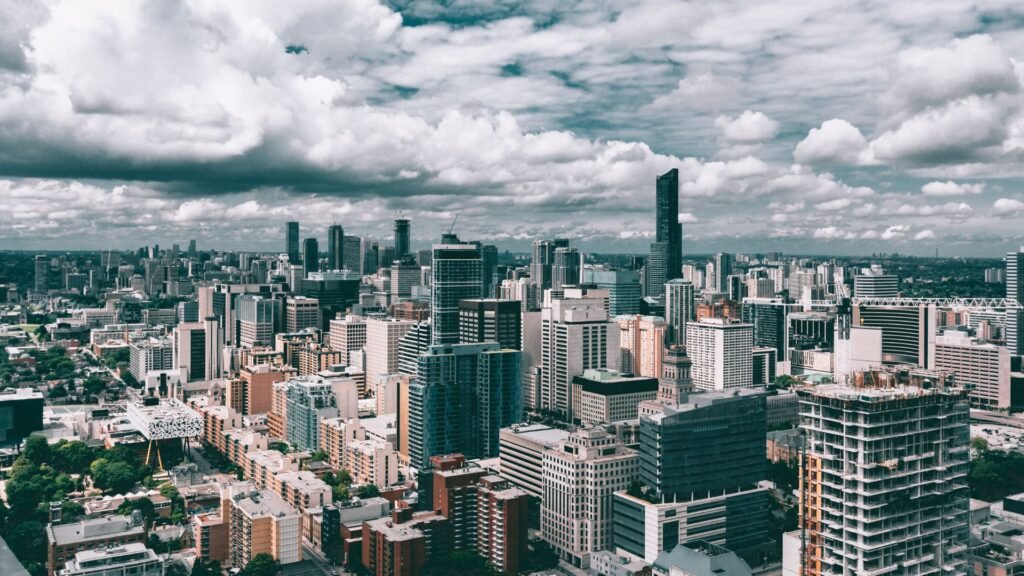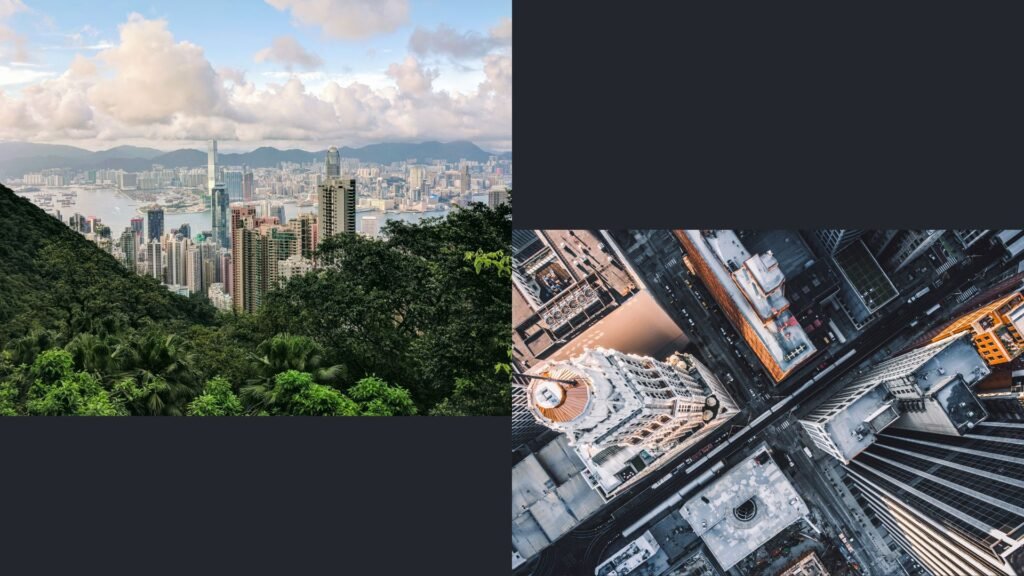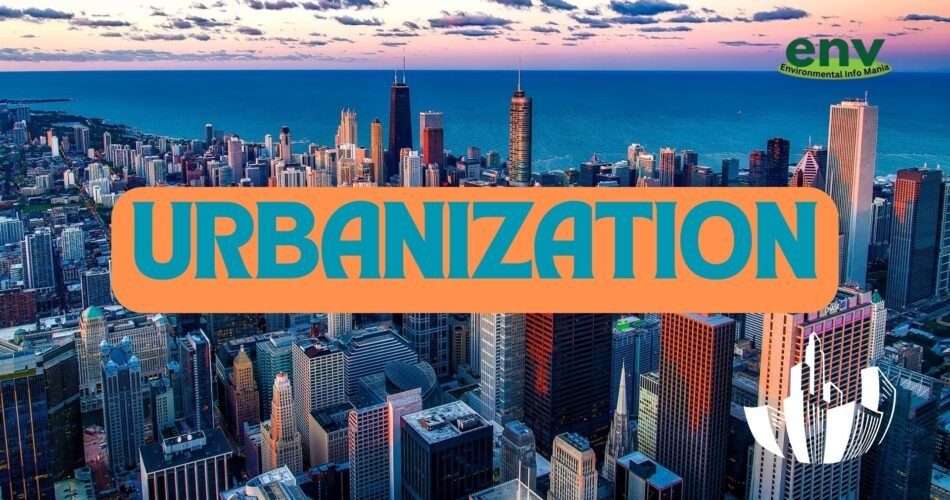This blog is all about the process of Urbanization, Urban vs Rural Areas and Causes of Urbanization. It also discusses the Positive and Negative Impacts of Urbanization with detail. This blog will clear the concept of the reasons behind Urbanization and its impacts on Resources and the Environment. In the end, It discusses the Sustainable Urbanization Solutions in detail.
1. Define Urban Area?
Urban Area are the regions that are surrounding a city. Most of the residents of Urban Areas have Non-agricultural jobs. These areas are developed, populated and density of Human Structures.
We can characterize the urban locations as the densely populated areas with developed infrastructure. These areas are the most modern areas and are a mix of commercial, residential and other land uses. These are considered as the most important areas and most of the Economic Stability and contribution relies on Urban tarretories. There are some types of Urban Areas according to their area and characteristics.
2. What are the Types of Urban Areas?
Following are the Types of Urban Areas:
i. Conurbation:
It is a large urban area that is formed as a result of merge of two cities. This makes a very large area by the merging of two smaller or big cities. Conurbation is a big developed geographical area.
ii. Agglomeration:
Agglomeration is a central city that expands due to including of smaller towns. It is a small city that get extended by addition of nearby small towns into the city. It collectively is a big network.
iii. Metropolitan City:
A metropolitan city is a big city with a population between 1 to 5 million. It is a huge system in which millions of people live and settle in the city. It is a developed and full of opportunities, urban area.
iv. Megacity:
Megacity is a very big geographical area that accommodates more than 5 million people in its region. This is always a big city and have a high population density of more than 5 million people.
v. Megalopolis:
It is characterized as the chain or metropolitan areas and it is a heavily populated urban area. This area is a chain of many large urban areas that are densely populated. It is a biggest urban area network.
This blog is all about Urban vs Rural Areas, Causes and Impacts of Urbanization
3. What is Urbanization?
Urbanization refers to the process by which large numbers of people move from rural areas to urban areas, resulting in the concentration of populations in cities. This is the appropriate Urbanization Definition.
History of Urbanization:
The process of urbanization was not so frequent and common in the past time. Because the Economical conditions and Lifestyle of the people was almost the same when the world was not much modernized or developed. People mostly take advantages from Agriculture and Natural Resource Utilization as their profession and way of income for them. There were no Industries and also Transportation options. People were living a simple life in which they easily meet the needs of their Family.
After the start of Industrial era and Industrial Processes, the Urban area started getting modernized and progressed as compared to Rural Area. As this type of Lifestyle and industrialization grew, the work opportunities and living standards started to improve in Urban Areas. While rural areas, still relies on the agriculture, farming practices and small businesses. The Medical and education facilities were also improving in the Urban locations, while people in rural areas suffer a lot for getting good education and medical facilities. These differences influence the process of Urbanization.
Present Scenario of Urbanization:
In last few years, as now there is a big difference between Rural lifestyle and Urban lifestyle, so the Urbanization became more frequent and common. As everyone started migrating to Urban Areas in search of job opportunities and upgrading the living standards of their families and also enjoying all the luxuries and facilities of Urban territories. At the same time Urban Populations are facing health issues due to Pollution and inappropriate Environmental Conditions. These health impacts includes Cardiovascular Diseases, Hypertension, Respiratory diseases etc. This blog is all about Urban vs Rural Areas, Causes and Impacts of Urbanization. We can evaluate the differences of Urban and Rural Areas by using Urbanization rates, urbanization data and land-use changes etc.

4. What is the difference between Urban Areas and Rural Areas?
Urban Areas:
Rural Areas:
1: Urban areas are developed areas with a lot a great population density.
1: Rural areas are less developed areas with less population in the region.
2: There is a high accessibility of information in Urban Areas.
2: There is a low accessibility of information in Rural Area.
3: There is a high accessibility of services in Urban Area.
3: There is a low accessibility of services in Rural Areas.
4: Urban areas represents liberal and radical elements.
4: Rural areas represents conservative perspectives and show resistance to change.
5: The migration levels are high and generally it is in the form of In-migration.
5: The migration levels are low and generally it is in the form of Out-migration.
6: There low fertility and low mortality rates in Urban Areas.
6: There is high fertility and high mortality in Rural Areas.
7: The quality and level of Education is high in Urban Areas.
7: The quality and level of Education is low in Rural Areas as compared to Urban Areas.
8: Example of Urban Area:
Big cities with industries, buildings, huge construction projects and Modern Infrastructure etc.
8: Example of Rural Area:
The hub of Agricultural and Farming Activities and simpler lifestyle with less facilities etc.
5. Why Urbanization is most common?
Urbanization is the most common because it plays a great role in raising the living standards of people living in Rural Areas. There are much more facilities in Urban areas, so people coming from other areas fascinates from its facilities, luxuries and living standards. The focus of this present era is development and progress. So everyone in this world want to raise the standards of living and this is the reason most of the people want to migrate to Urban location and developed areas. Most of the people want to live luxurious life and are tired of less facilities for Health and Education. This is the reason why it is common in present era. This blog is all about Urban vs Rural Areas, Causes and Impacts of Urbanization.
6. What are the main Causes of Urbanization?
There are many common causes of Urbanization. These causes are as follows:
1. Employment Opportunities:
The employment opportunities of Urban areas are much better than that of Rural areas. People mostly move towards the urban areas to find better job opportunities and work options. The main reason behind it is that, the urban areas contain big and small Industries, Factories, Shops and Offices to work. This is the one of the most Important Causes of Urbanization.
2. Industrialization:
Industrialization is an important factor for attracting the people towards urban areas. It includes all the steps that are required for Industrial processes and transportation for the products so this all collectively makes a network of developed and progressive system that creates many jobs for the people below poverty line. In this way, many people from the lower areas migrate to Urban locations in search of work.
3. Better Education Facilities:
Urban areas are famous for better Educational Institutes, Facilities, Faculty and Economic requirements. While rural areas and sub-urban areas lack Education institutions and resources, and there is a high rate of illiteracy. This quality makes urban areas better than rural areas and cause many people to shift their families to urban areas for better education resources.
4. Better Medical Facilities:
Rural areas and small cities do not have better and suitable medical and health facilities. There is high rate of mortality and diseases in less developed areas. So, people suffer a lot in getting proper medical facilities and Expert Medical Professionals. While Urban area, have high quality Medical centers and institutes for better medical facilities. The people also want to enjoy better medical facilities.
5. Limited Employment:
There is a very limited Employment opportunities due to agricultural activities in Rural areas. All the basic employments are related to Agricultural Sector. Other employment options are very less mostly in rural areas. Urban areas have many employment opportunities and also the options to choose better work for them. Limited Employment in rural areas cause the people to migrate for better employment options.
These are few main causes of Urbanization. If we can deal with these cause we can control it. This blog is all about Urban vs Rural Areas, Causes and Impacts of Urbanization.
7. What are the Major Environmental Impacts of Urbanization?
Following are some of the Environmental Issues that are triggered by Urbanization:
1: Urbanization and Water Quality:
Urbanization has a severe effect on the Water Quality. The urbanization system contributes in pollution, stormwater runoff, and habitat degradation. All of these leads to disturbances in Marine Ecosystems and deteriorates water quality and ends up as Water Pollution. This can also be called as Urban Stream Syndrome which is a term used for describing ecological degradation that drain urban areas. Impervious surfaces like roads and buildings pollutes more than rural areas.
2: Loss of Biodiversity and Urbanization:
Urbanization consists of non-sustainable construction practices, chemical use, inappropriate treatment of plants and animals, and running industries. All of these activities in urban areas leads to great Loss of Biodiversity because of water pollution, habitat destruction and Air Pollution. In this way, the Biodiversity in Rural Areas is in much better quality than the Biodiversity in Urban Areas. Thus also leads to Riparian Zone Degradation, which means removal of vegetation along waterways and effecting stream health.
3: Urbanization and Climate Change:
The Carbon Footprint and Energy use of Urban Areas is much higher than Rural Areas. Industrial Pollution also give rise to Greenhouse gas emissions that are the main reason behind Climate Change. These Industrial Activities, Overexploitation of Natural Resources and Overuse of Energy, leads to extreme Pollution levels whether it is Air Pollution, Light Pollution and Water Pollution. This automatically leads to Climate Change causing Extreme Weather and Temperature variation. Urban Heat Island effect is the term that defines the phenomenon in which the cities are warmer than the surrounding rural areas due to Industrial and Construction Activities.
4: Overpopulation and Urbanization:
Overpopulation is a severe Environmental Issue of the present era. It cause Environmental degradation in various ways. For example, when there will be more people in a compact region, there will be more need of energy, food, residential areas, water and all other fundamental needs of people. This will lead to increased Greenhouse gas emissions, excessive resources, difficult pollution control, food and water supply. So, overpopulation is dangerous in both Environmental and Ecological aspect and it is mostly found in Urbanization.
5: Greenhouse Gas Emissions and Urbanization:
The process of urbanization and development is the biggest source of Greenhouse Gas emissions. It is because the urbanization is the enhancement of Industrial Activities that includes Fossil Fuel Burning, Transportation, Carbon emissions etc. All these gases contributes in GHGs and produce Warming effect into the Environment, ending up into Global Warming and Climate Change. The excess of urbanization is raising average temperature of the Earth by producing GHGs.
6: Waste Disposal Problems:
When the population is high in a geographical region, the waste production is also high as the population. It is very difficult to plan and strategize the proper disposal and treatment of the wastes. There is no space for dumpsters, and the waste is a lot to manage properly. So, as compared to rural areas, it is difficult to manage and control the wastes in Urban areas, because of excessive consumption of goods and products and a huge amount of waste in comparison with the region.
7: High Energy Consumption:
There is a high energy consumption in Urban Area. The energy is consumed by too many appliances in use and the overall consumption become much more than the Rural areas. People of urban areas us more Electricity, Electrical Appliances, Assistive gadgets and many more things that consume Electricity or power in different ways. This makes Urbanization costly because the use of energy in these areas is very high and the consumption continues to increase in these areas.
8: Residential Issues:
If many people from nearby villages and areas will come to a big city or developed urban area, it will be difficult to provide residents to all the migrated people. This is a common problem in urban areas that people struggle to get their homes and also proper residents in big cities. There are many such issues include lack of land, lack of resources to afford residence and many other difficulties in Urban Areas. It is difficult to accommodate and live peacefully after migration in Urban areas. This mostly leads to Urban Sprawls or expansion of urban areas into rural areas that leads to Social and Environmental challenges.
9: Pollution and Urbanization:
Urbanization is the biggest reason behind all types of pollution increase. This starts when many people lives in the same area and the city is over-crowded, this cause great levels of wastes and pollution of every kind. Industrial Pollution, Land Pollution, Water Pollution, Air Pollution and Plastic Pollution is very common in urban areas. The ratio of contribution of these pollutions is greater in urban areas as compared to rural areas. It also cause Deforestation in most of the cases.
10: Water shortage and Urbanization:
As a high population density lives in a specific geographical area, so the fundamental resources such as Food, Water and Shelter become less for the population. The issue of water shortage is on the top of Environmental problems in the present era. Because freshwater is becoming scarce on Earth. Urbanization is the main reason behind water shortages in the world because it holds populations more than the capacity of the available resources. This is also known as Hydrological Impacts of Urban systems.
These are some of the Environmental Impacts of Urbanization. This blog contains Causes and Impacts of Urbanization.
8. What is the list of some Positive Impacts of Urbanization?
Following list shows the positive Impacts of Urbanization on Earth:
- Urbanization provides you better Educational Facilities and Institutions.
- It also provides you better Safety and Law facilities than Rural areas
- This also offer better options for Employment and Work Opportunities.
- Urbanization lets you take advantage from better Medical Facilities and guidance from Health Experts in the city.
- It provides you better awareness about latest trends of the world and also the awareness about Development.
- Urbanization may bring Technological and Infrastructural Advances for the cities.
These are some of the positive Impacts of Urbanization. This blog contains Urban vs Rural Areas, Causes and Impacts of Urbanization.
9. How Urbanization Effects Public Health and Social Inequality?
Urbanization and Public Health:
Urbanization has very bad effects on the Public Health. As all dangerous activities such as Industrial Activities, Transportation, Fossil Fuel Burning, etc. are carried out in Urban Areas. The main reason behind health risks are Air Pollution, Plastic Pollution and Water Pollution. These problems cast following effects on Public Health:
- Respiratory Disorders
- Cardiovascular Disorders
- Water-borne Diseases
- Hypertension
- Heat-related illnesses
- Occupational Diseases etc.
These are some of the Health Effects of Urbanization.
Urbanization and Social Inequalities:
Urbanization play a very integral part in creating social inequalities. The urban areas are places where people of all classes live in the same region. Some people are rich with facilities, resources, food and water while some are people even without fundamental needs of life. So, this creates social inequality between people and this gives rise to many conflicts, crimes and bad relations. Following are some effects of Social Inequalities:
- Poverty
- Hunger
- Unequal Distribution of Wealth
- Political Instability
- Poor health and Diseases
- Decrease in Social Cohesion
- Reduced Economic Growth etc.
These are some of the Effects of Social Inequalities. This blog contains Causes and Impacts of Urbanization.
10. What are Sustainable Urbanization Solutions?
Sustainable Urbanization is the practice cities or urban areas that are long-lasting, resource-efficient and have Minimal Environmental Impact. It is the concept of transforming cities into Environmentally friendly systems and consumption. In this way the Carbon Footprint, Exploitation of Resources and Industrial Activities Impacts will be minimized and stabilized.
Sustainable Urbanization Solutions:
Following are some of the Sustainable Urbanization Solutions that can help to make cities Sustainable and reduce their Environmental Impact:
Sustainable Transportation:
Sustainable Transportation will help us to reduce the excessive Transportation Pollution that is main cause of Global Warming and in Urban Area gives rise to Transportation Pollution. This will reduce the Carbon Footprint of Transportation. Example: Using Public Transport, Electric Vehicles, Driving Smart etc.
Trees and Green Spaces:
Trees and Forests in the urban areas help in reducing the severe impacts of Air Pollution. We should promote Plantation and Forestry in the Urban Areas. In the same way, establishment of Green Spaces and vegetation help us to built aesthetic as well as Eco-friendly environment. Example: Urban Forests, Parks, Gardens etc.
Green Infrastructure:
Green infrastructure consists of specialized designs and systems that helps in reducing Environmental Impacts of urban areas, reducing resource consumption and also for proving Environmentally friendly environment for people and Biodiversity. Example: Green Buildings, Water Management systems, Green roofs, Green walls etc.
Sustainable Development:
Sustainable Development refers to the idea of developing Urban Areas without harming the Environmental Components and Biodiversity. It promotes the Sustainable Construction activities, conservation of green spaces, Renewable Energy Adoption etc. Example: Establishing specie corridors in the new projects of road construction, saving trees during construction activities etc.
These are some of the Sustainable Urbanization Solutions that helps us to fight with the Environmental and Social impacts of Urbanization.

11. Conclusion:
Urban areas are the densely populated and also developed areas in a city or they are made up of combined cities. These areas are of five types, Conurbation, Agglomeration, Metropolitan City, Megacity and Megalopolis. There are many differences between urban and rural areas and so as these differences are the reason behind increased urbanization. The cause of it includes Employment opportunities, Better Health facilities, Educational Facilities etc. The positive impacts of Urbanization includes Better Medical Facilities, Innovation and Technology, Industries, Job Options etc.
As Urbanization is very useful for progress and development, but it has very bad impacts on the Environment as it is the biggest cause of Pollution, Waste Disposal Problems, Green House Gases emissions etc. We should provide equal facilities to the people of villages and small cities to control this practice.
To learn about more topics, Click the links below:


Comments